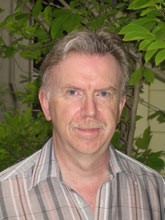
Handy Links
SLAC News Center
SLAC Today
- Subscribe
- Archives: Feb 2006-May 20, 2011
- Archives: May 23, 2011 and later
- Submit Feedback or Story Ideas
- About SLAC Today
SLAC News
Lab News
- Interactions
- Lightsources.org
- ILC NewsLine
- Int'l Science Grid This Week
- Fermilab Today
- Berkeley Lab News
- @brookhaven TODAY
- DOE Pulse
- CERN Courier
- DESY inForm
- US / LHC
SLAC Links
- Emergency
- Safety
- Policy Repository
- Site Entry Form

- Site Maps
- M & O Review
- Computing Status & Calendar
- SLAC Colloquium
- SLACspeak
- SLACspace
- SLAC Logo
- Café Menu
- Flea Market
- Web E-mail
- Marguerite Shuttle
- Discount Commuter Passes
-
Award Reporting Form
- SPIRES
- SciDoc
- Activity Groups
- Library
Stanford
Around the Bay
From the Director of PPA: Following the Science and Expanding the Toolkit

Last Thursday's annual meeting of the SLAC Users Organization was another reminder of both the fundamental nature of the questions confronting particle physics, particle astrophysics and cosmology today and the breadth of the toolkit being arrayed to address these questions. It was also a reminder of the importance of maintaining the partnership between Particle Physics and Astrophysics at SLAC and the university community, as together we expand physics horizons and the experimental toolkit.
At the meeting we were treated to spectacular science from the Fermi Gamma-Ray Space Telescope, just past the first anniversary of its launch into high Earth orbit last June. In the first year of operation some 50 gamma-ray pulsars, a number of remarkably energetic emissions from gamma-ray bursts, a very high statistics measurement of the cosmic electron/positron flux and an array of searches for dark matter signatures are just a sampling from this unique observatory. Fermi is also a pioneering marriage of particle physics and astrophysics, as well as university and laboratory capabilities, that points the way to our future.
That future, now in the planning stages, focuses on the nature of dark energy using a variety of precision measurements to map out the history of the expansion rate of the Universe. The Large Synoptic Survey Telescope on a Chilean mountaintop and the Joint Dark Energy Mission in space will provide definitive next-generation measurements addressing perhaps the greatest mystery emerging from cosmology. Clearly these projects expand the toolkit well beyond accelerator-based experiments, but they nevertheless are also powerful examples of the blend of astrophysics and particle physics techniques driven by a common fundamental science question.
Opportunities to probe the energy scale and the physics at the very earliest times after the Big Bang, a period of rapid inflation that is the hallmark of modern cosmology, were also on the menu of future experiments, including efforts to detect the curl or B-mode components of the Cosmic Microwave Background radiation. AGIS, a proposal under development for a ground-based air Cherenkov array, would be the natural successor to the Fermi gamma-ray science program.
Beyond satellites in space and telescopes on mountain tops, there are also fundamental questions to be addressed deep underground. In this case, the Earth provides shielding needed to create a radiologically quiet environment to search for the very rare. Is the neutrino its own antiparticle? Can we detect the relic dark matter left over from the Big Bang that permeates the Universe around us? The Enriched Xenon Observatory and the Cold Dark Matter Search experiment may be able to answer these questions. Here again continues the theme of exporting capabilities and techniques from the accelerator-based experimental world to expand the toolkit confronting fundamental science questions.
After being treated to this array of existing and future opportunities in space, on mountain tops and deep underground, the SLUO meeting then turned to explore the evolution of a more familiar toolkit of accelerator-driven particle physics. This included the energy frontier science near-term at the Large Hadron Collider with the ATLAS experiment, and longer-term at a future linear collider. Fundamental science questions once again drive the energy frontier program: the origins of mass, the nature of Dark Matter, the symmetries of nature and the nature of gravity. Here too the theme of PPA partnership with the community is very much in evidence, with our close ties to the U.S. ATLAS community intended to enhance prospects for an early scientific payoff on the key science questions. Likewise today's strategic program of ILC R&D, and laser and plasma advanced acceleration experiments, are driven by the imperative of the science case for a high-energy linear collider. At the intensity frontier we may also see a future very-high luminosity collider as the next generation successor to the present-day PEP-II and KEKB B Factories.
Overall, I found the SLUO meeting an important affirmation of letting the big science questions of particle physics, particle astrophysics and cosmology lead the way in defining the instruments of choice and the experimental toolkit. This toolkit has clearly expanded well beyond its roots in accelerator-based experiments, thereby representing a fresh and exciting challenge in its own right. The meeting was also an opportunity to look once more at finding new ways to continue the effective partnership between PPA and the university community. These are common themes that will continue to define SLAC's PPA program as it evolves over the next few years.
Thanks to Gerard Bonneaud and SLUO for putting together such a stimulating program.
